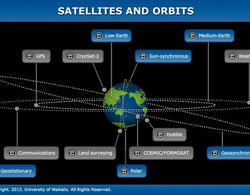Name: Optus D1
Satellite number: 29495
Owner: Australia
Mission: communications, satellite broadcast
Launch date: 2006
Type of orbit: geostationary high-Earth orbit
Period: 24 hours
Perigee: 35,771 km
Apogee: 35,802 km
Transcript
Dr Allan McInnes
Communications satellites are satellites that are up there specifically to communicate. Part of that communication will be the usual commands and signals we get from any satellite, but more importantly what we call the payload of the satellite – its whole reason for being – will be some kind of huge collection of powerful radio transmitters and maybe a big dish or something like that, to enable it to talk to things on the ground. And we’ll use them to transmit TV signals, to transmit radio signals, and in some cases, it might be to be transmit internet signals. So all of that gets turned into radio somehow and transmitted up into space and then bounced back down somewhere else.
You can almost think of them as being like a giant reflector in the sky. We fire a signal up at this thing that’s floating up there, at 36 000 kilometres and it bounces a signal back down. Early ones really did just reflect it. Newer communications satellites have onboard receivers and amplifiers and things so they’ll take the signal that they receive, they’ll do some processing on it to clean it up so that any distortion that’s occurred during the transmission gets fixed and then they’ll rebroadcast it back down again.
Communications satellites, how big are they? Well the main part of the satellite, would probably be about the size of a small car. Most of them weigh between 3 and 5 tonnes. But then because it’s a communications satellite, it’s using a lot of power, which means it needs big solar arrays to generate that power, so you might see 50-metre long solar arrays sticking out either side of the satellite. And most of them are flying, up and around geosynchronous orbit or geostationary orbit – usually geostationary for communications satellites because that makes it easier for them to talk to things on the ground. That means they also to need to produce huge amounts of power because they’re a long way away and they need the radio transmissions to go a long way.


